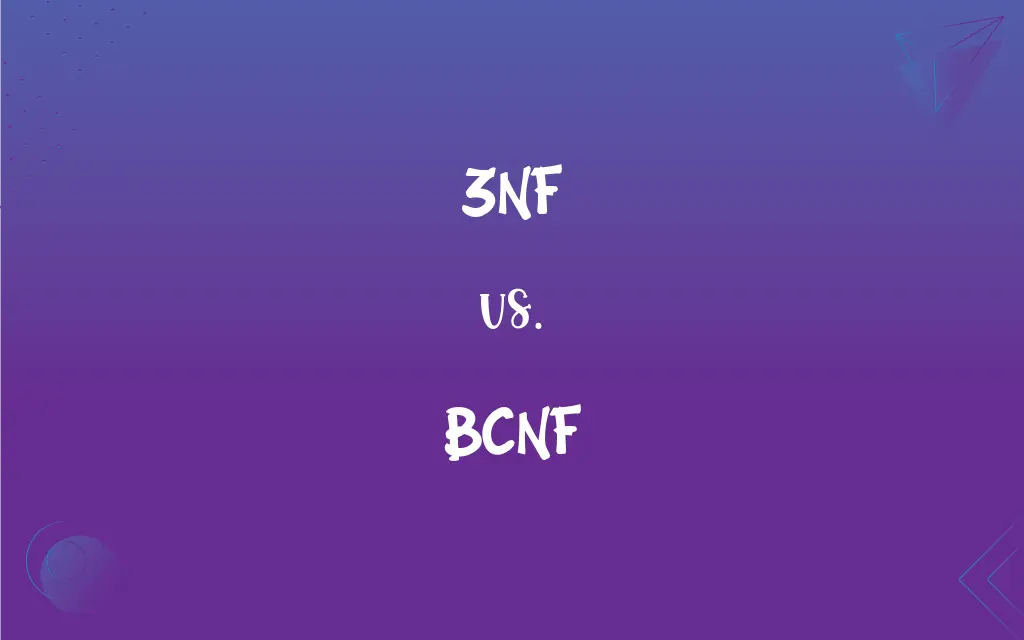3NF vs. BCNF: What's the Difference?
Edited by Aimie Carlson || By Harlon Moss || Published on February 10, 2024
3NF (Third Normal Form) eliminates transitive dependency from tables, whereas BCNF (Boyce-Codd Normal Form) is a stricter version of 3NF addressing certain types of anomalies not covered by 3NF.

Key Differences
3NF, or Third Normal Form, is a database normalization step ensuring every non-key attribute is fully functionally dependent on the primary key. In contrast, BCNF, or Boyce-Codd Normal Form, goes a step further by addressing cases where non-trivial functional dependencies exist on a superkey. 3NF focuses on removing transitive dependency, while BCNF aims to eliminate certain anomalies left by 3NF.
In 3NF, a table design must not have any transitive dependency, which means non-prime attributes must be dependent only on the primary key. However, BCNF demands that for every functional dependency (A → B), A must be a superkey. This difference means BCNF can sometimes require further decomposition of tables than 3NF, potentially leading to more tables.
3NF is often considered sufficient for most practical database designs, focusing on the functional dependency of attributes on the primary key. BCNF, being stricter, can sometimes lead to more complex database designs but with the advantage of reducing redundancies and potential update anomalies.
A table in 3NF is free from all modification anomalies, provided it does not violate any BCNF condition. However, a table in BCNF is always in 3NF, but the converse isn't always true. BCNF addresses certain types of dependencies that can cause redundancy even in 3NF tables.
Both 3NF and BCNF aim at normalizing database tables to reduce data redundancy and improve data integrity, BCNF is often harder to achieve in practice due to its stricter requirements. Implementing BCNF can result in more fragmented table structures, which could impact database performance.
ADVERTISEMENT
Comparison Chart
Definition
Eliminates transitive dependency.
Eliminates anomalies not addressed by 3NF.
Dependency Focus
Non-key attributes dependent on primary key.
Every functional dependency on a superkey.
Suitability
Often sufficient for most database designs.
Stricter, leading to more complex designs.
Anomalies
Removes all modification anomalies.
Addresses specific redundancy anomalies.
Complexity and Implementation
Less complex, easier to achieve.
More complex, can lead to fragmented structures.
ADVERTISEMENT
3NF and BCNF Definitions
3NF
Eliminates transitive dependencies in database tables.
In a table with attributes StudentID, Course, and Instructor, Instructor depends only on Course, fulfilling 3NF.
BCNF
A stricter version of 3NF addressing more complex anomalies.
In a table with CourseID, ProfessorID, and Department, ProfessorID and Department are dependent on CourseID.
3NF
Aims to reduce data redundancy and improve data integrity.
A table with BookID, Title, and AuthorName, where AuthorName depends solely on Title.
BCNF
Every determinant must be a candidate key.
In a table with Room, Building, and Capacity, Building and Room together form a candidate key.
3NF
Every attribute must be directly dependent on the key.
In a table with PatientID, AppointmentDate, and Doctor, Doctor is directly dependent on AppointmentDate.
BCNF
Eliminates redundancy for tables in 3NF.
A table with BookID, PublisherName, and PublisherAddress where PublisherName is a superkey.
3NF
Ensures every non-key attribute is fully functionally dependent on the primary key.
In a table with StudentID and BirthDate, BirthDate is directly dependent on StudentID.
BCNF
Addresses cases where functional dependencies are on a superkey.
In a table with EmployeeID, ProjectID, and Role, EmployeeID and ProjectID together form a superkey.
3NF
Non-prime attributes must not depend on other non-prime attributes.
In a table with EmployeeID, Department, and DepartmentLocation, DepartmentLocation depends only on Department.
BCNF
Demands that for every functional dependency A → B, A is a superkey.
In a table with StudentID, CourseID, and Grade, StudentID and CourseID together are a superkey.
FAQs
What is 3NF in database design?
3NF is a normalization form ensuring that all non-key attributes are fully functionally dependent on the primary key.
How does BCNF differ from 3NF?
BCNF is a stricter form of 3NF, addressing additional anomalies by ensuring every functional dependency is on a superkey.
What is the primary goal of 3NF?
The primary goal of 3NF is to eliminate transitive dependencies in database tables to reduce redundancy and improve data integrity.
Is BCNF always achievable in database normalization?
While BCNF is desirable, it's not always achievable or practical due to its strict requirements.
Is it easier to achieve 3NF or BCNF?
It is generally easier to achieve 3NF due to its less strict requirements compared to BCNF.
Can a table be in BCNF but not in 3NF?
No, if a table is in BCNF, it is automatically in 3NF.
What kind of dependencies does 3NF focus on?
3NF focuses on ensuring that all attributes are fully functionally dependent on the primary key, eliminating transitive dependencies.
How does BCNF improve database design?
BCNF improves database design by further reducing data redundancy and potential update anomalies beyond what 3NF achieves.
What is an example of a table in 3NF?
A table where each non-key attribute is fully functionally dependent on the primary key, like a student table with StudentID, Name, and Birthdate.
Are there any drawbacks to using BCNF?
The main drawback of BCNF is that it can lead to greater complexity and potentially more fragmented database structures.
What is a superkey in the context of BCNF?
A superkey is a set of one or more columns in a table that can uniquely identify any row in that table.
Is BCNF always necessary for database normalization?
BCNF is not always necessary; it depends on the specific requirements and the nature of the data in the database.
Why is BCNF considered stricter than 3NF?
BCNF is considered stricter because it requires every functional dependency to be on a superkey, addressing more complex types of anomalies than 3NF.
What are transitive dependencies in 3NF?
Transitive dependencies in 3NF are situations where a non-key attribute depends on another non-key attribute, which 3NF eliminates.
Can a table be in 3NF and still have anomalies?
Yes, a table can be in 3NF but still have certain types of anomalies, which BCNF aims to resolve.
What is an example of a table in BCNF?
A table where every determinant is a candidate key, like a course table with CourseID, InstructorID, and Department, where CourseID and InstructorID form a superkey.
How does functional dependency relate to 3NF and BCNF?
In 3NF, functional dependency focuses on the primary key, whereas in BCNF, the dependency must be on a superkey.
Why might BCNF lead to more tables in a database?
BCNF can lead to more tables because its strict rules may require further decomposition of tables to eliminate more complex anomalies.
Does 3NF address all types of data anomalies?
3NF addresses many types of anomalies but not all; BCNF is needed to address certain complex anomalies.
Can a database be normalized beyond BCNF?
Yes, there are higher normalization forms beyond BCNF, such as 4NF (Fourth Normal Form) and 5NF (Fifth Normal Form).
About Author
Written by
Harlon MossHarlon is a seasoned quality moderator and accomplished content writer for Difference Wiki. An alumnus of the prestigious University of California, he earned his degree in Computer Science. Leveraging his academic background, Harlon brings a meticulous and informed perspective to his work, ensuring content accuracy and excellence.
Edited by
Aimie CarlsonAimie Carlson, holding a master's degree in English literature, is a fervent English language enthusiast. She lends her writing talents to Difference Wiki, a prominent website that specializes in comparisons, offering readers insightful analyses that both captivate and inform.































































